Here I am, hanging out in the 1970s again—I discovered that the full text of old School Library Journals are available via our statewide digital library, so I’ve been dipping into them during quieter moments at the circulation desk.
In the September 1974 issue—the first stand-alone issue after spinning off from Library Journal—there’s an essay by Ursula Nordstrom called Assorted Thoughts on Creative Authors and Artists that contains the following about Charlotte Zolotow:
But Charlotte herself is not all sweetness and light, thank goodness. Some time ago she was expressing a great deal of rage to me about someone she disliked intensely. This person, Charlotte felt, was always putting others down, was always critical. It made Charlotte furious. She was so full of this anger that I, as her friend and editor, sought to break some of the tension by saying mildly, “You should write about it. I hate to see all this emotion lying around loose and going to waste.” Sometime later I was delighted to have Charlotte put a manuscript on my desk which told about two little girls—one a put-down specialist who jars the other into independent thinking. It is The Unfriendly Book, to be published in the spring of 1975.
So obviously—and I suspect, exactly as Nordstrom intended—I had to track it down.
And boy howdy, was I glad I did.
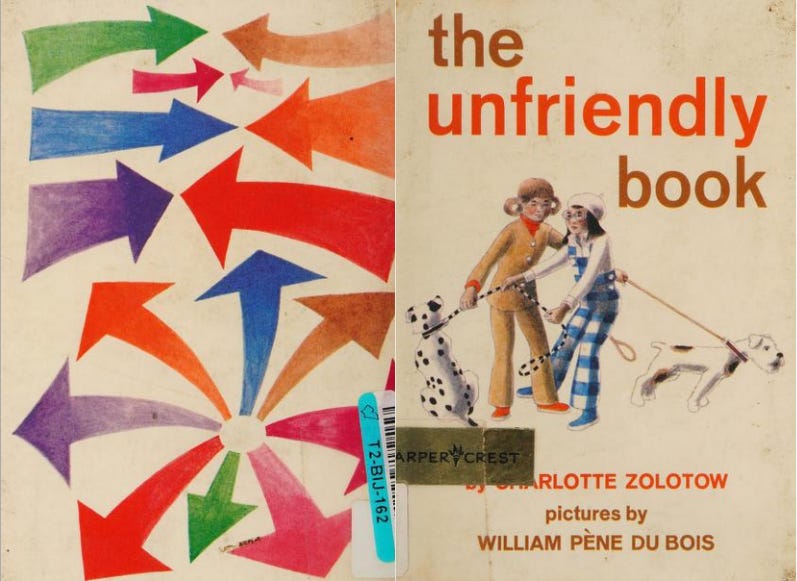
It’s a super simple story: Two girls are out walking their dogs. Judy wants to hang out with some of the other girls they know, and Bertha takes issue with every single one of them. Each two page spread features the girls, their dogs, and their conversation on one page, and a full page illustration of the girl in question on the other.
What makes it a blast is that the illustration of each girl in question changes depending on whose opinion is being expressed. So for example, here we’ve got Bertha’s nasty take on Marilyn:
And then on the next two pages, we’ve got Judy’s take on Marilyn:
I love that the girls they’re talking about are wearing the same clothes and have basically the same features—it’s always clear that they’re talking about the same kid—but the details are different depending on whose perspective is foregrounded. And so while it’s not explicit in the text, the book plays with the idea that we all look at the world through our own filters—the idea that assuming our own personal opinions are the same thing as objective reality leaves us standing on a wobbly, slippery foundation.
(Unrelated: I have at least two capes like that. I love them and wear them a lot in the fall, and boy oh boy my 70s fixation really never ends, does it?)
So they back and forth about different kids in the class, and crucially, they are ultimately UNABLE TO COME TO ANY SORT OF AGREEMENT.
Bertha is DISGUSTED with Judy, and accuses her of just liking EVERYONE, to which Judy says:
AND THAT’S THE END OF THE BOOK.
It’s… awesome? Being honest with kids about how sometimes walking away from someone is necessary and the best option is… AWESOME?
For sure, I understand the importance of children’s books that promote meeting in the middle and compromise and understanding differences; that it’s okay to enjoy different things and have multiple groups of friends and all that jazz. And obviously I love lots of those books.
But good grief, I cannot remember the last time I read a picture book that played out like this one. Showing kids—particularly girls—that they don’t have to put up with this kind of nonsense is fantastic. And showing Judy actively defending these other girls—not silently disagreeing because she doesn’t want to be rude or make Bertha feel bad or whatever it is we so often tell ourselves in situations like this—is also, as I said, awesome.
(That isn’t to say that other picture books along these lines aren’t out there! I read quite a lot of picture books, but I’m not as immersed in them as a lot of you are, so if you know of others, let me know in the comments—I’d love to read those, too.)
My one ding is that at least one of Pène du Bois’ Bertha viewpoint illustrations uses subtle fat-shaming as part of the perspective shift—in addition to the basic styling differences that he uses in the other spreads, the girl in question, Mary, is visibly slimmer in Judy’s viewpoint picture:
It’s not in Zolotow’s text, so I’m chalking it up to a choice on his part. While it certainly is a reflection of the dominant culture then (and now), it also works to reinforce it, which is, as they say, a bummer.
Dispatches from the 70s #1
Franklin Stein had been sawing and drilling, day and night, hammering, hammering in the locked attic room. His mother didn’t know what he was making, his father didn’t know what he was making, his snoopy sister Phyllis didn’t know what he was making.
Also read: The Phantom Cyclist and Other Ghost Stories
I hadn’t heard of The Phantom Cyclist before I came across it in the reviews section of the same issue of SLJ. And, you know me: Ghost stories are my jam.
The first couple of stories in this collection run along the same lines: A child interacts with a ghost, then something happens—sometimes the living child has control over that something, sometimes they don’t—and then the ghost stops appearing and the story ends with the realization that they’ll never see the ghost again.
The third story is where things take a turn. In that one, a boy is sent away to live with a distant relative while he recuperates from a lingering illness, and while he’s living there, he makes friends with a girl he meets in the garden. He realizes almost immediately—the kids in these stories aren’t dopes, they generally pick up on this stuff pretty quickly—that she’s the same girl depicted in a painting in his aunt’s house. To make it all even more interesting, he notices that if she gets muddy while they’re playing, the painting will have changed to reflect that when he goes back inside.
Featured in the rest of the stories: A ghost cat! A hotel haunted by a lady who likes to tuck kids in! A mirror that allows a girl to see—and travel—through time! And finally, a group of ghost kids who read a whole lot like fey folk—complete with an attempt to trap a brother and sister in their realm foreverrrrrrrrrrrrr!!
Note: I LOVED THE GHOST CAT.
The ghosts are almost always the ghosts of other children, so the stories grapple not just with the basic concept of mortality, but the possibility of dying very, very young. Ainsworth leans into the tragedy, but it never reads as weepy or maudlin—it’s all very matter-of-fact.
She works some quiet humor in, too. A few of the stories play around with the idea that modern kids and kids from The Past would have very different versions of “normal.” And so while all of the kids in these stories will read as old fashioned to readers in the present day, it’s fun to think about 70s kids reading these and being like OMG THE PAST WAS SO WEIRD LOL.
In this bit, the ghost girl is talking to our hero about why she’s only supposed to play “quiet games”:
“Because you’ve been ill?”
“Partly. And partly because of getting dirty and untidy. They want me to grow up into a lady.”
“You’ll do that anyhow,” said Giles seriously. “You can’t expect to grow up into a man.”
“Oh, not just that kind of a lady,” laughed the girl. “I don’t mind that. I don’t want to be a man and have to go to the wars. No, they just mean a fine lady. A grand lady. Someone who likes pretty clothes and has the vapors and doesn’t romp about.”
“What are ‘the vapors’?” asked Giles.
“I haven’t the least idea, but I don’t like the sound of them, do you? I’ve made up my mind never to have them. And I shall romp as much as I like!”
Romp it up, little ghost girl. DOWN WITH THE VAPORS!!




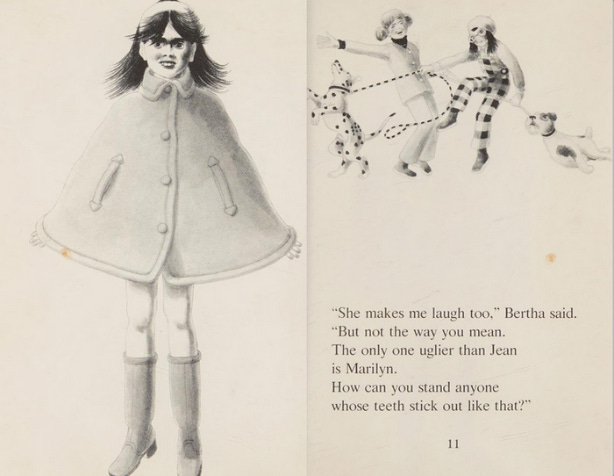
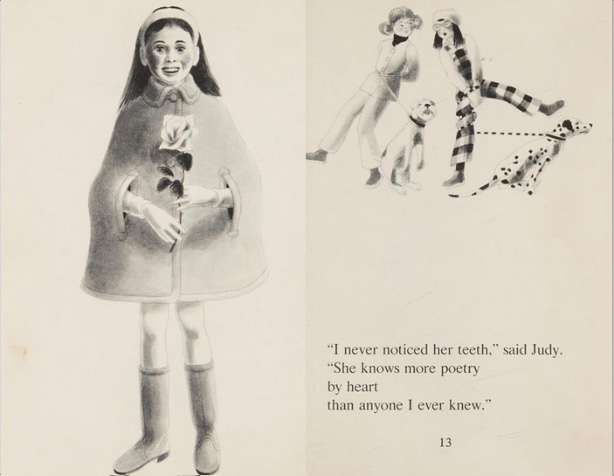

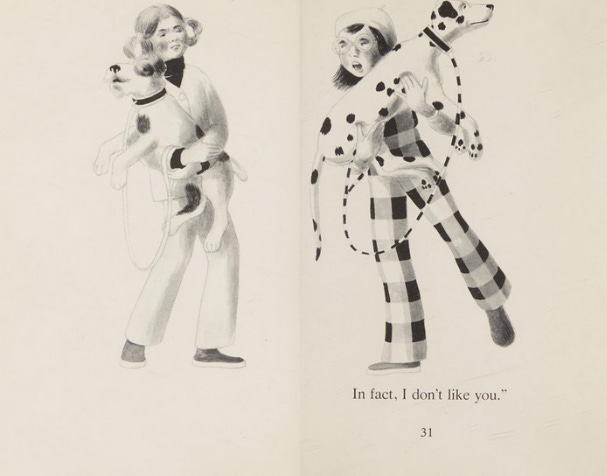
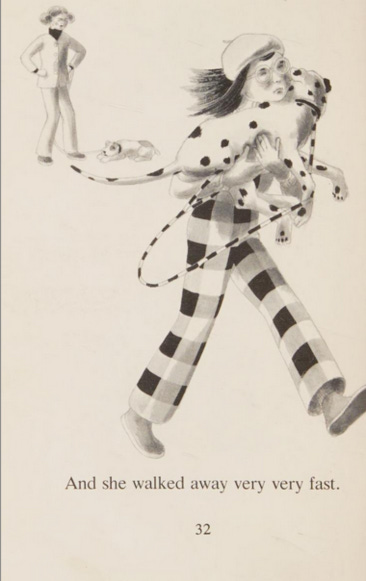
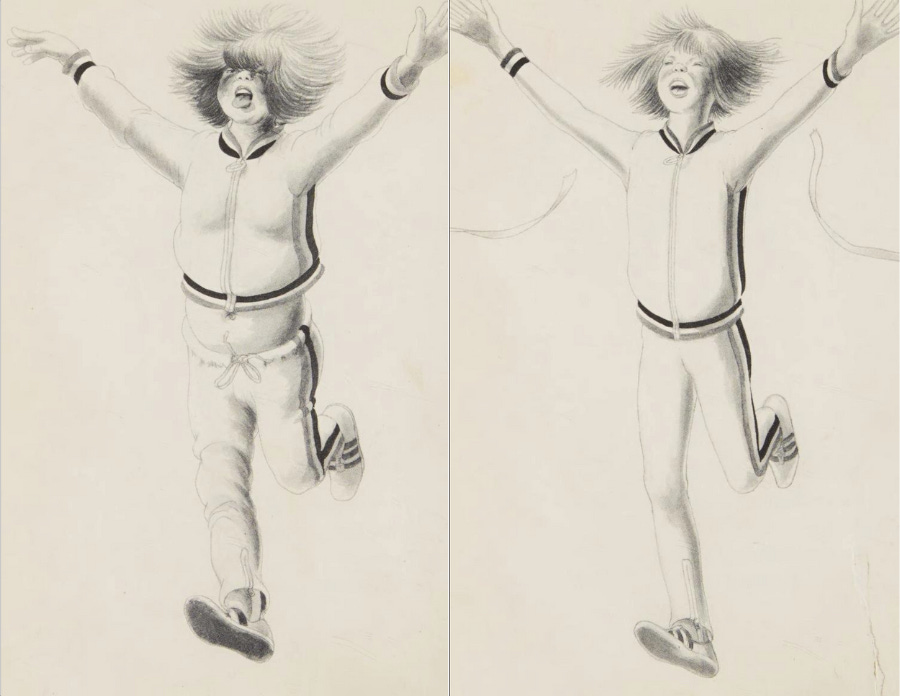

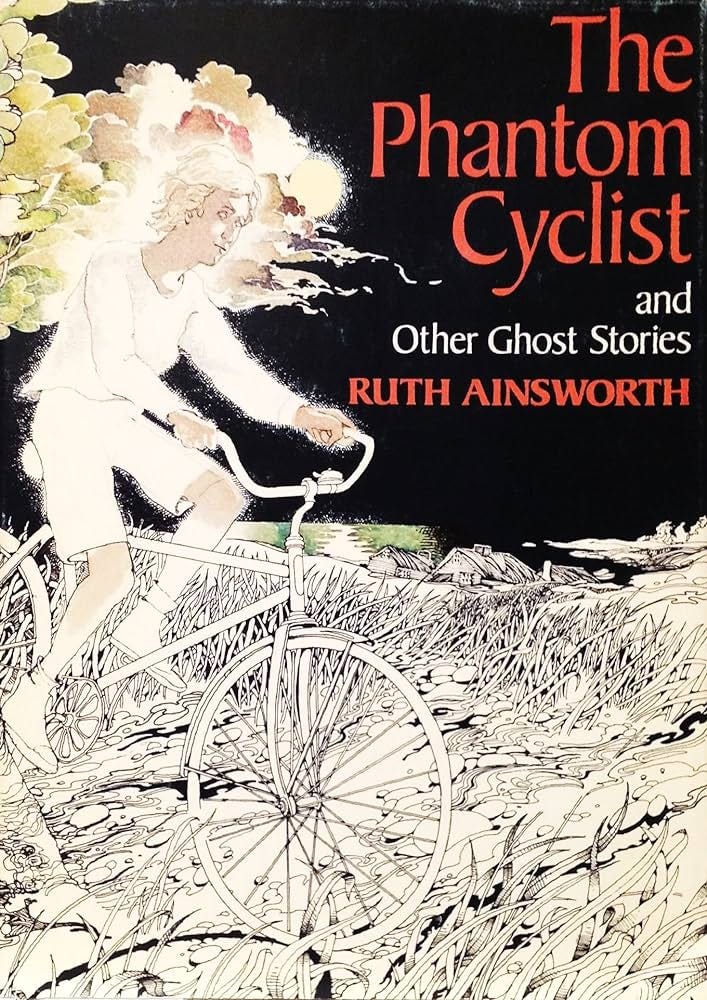
SUCH THOUGHTS! I've a plethora of them, but the loudest thoughts are:
1.) we need to lobby for a reprint, immediately - with a new illustrator, obviously, because the additional use of secondary sexual characteristics as part of the shaming of round bellies on the female body is gross and makes me want to reach through time and slap the illustrator - but mostly, we need this reprint yesterday and MOAR books featuring girls having irreconcilable differences and deciding, "No."
2.) I'll be seeking my own copy, posthaste, and hope there are more like this - and I also am a teensy bit resentful that I was a baby in this era and no one thought ahead to save me this book???
3.) I've been trying to be much more honest in my middle grade writings, and it's amazing how few of us feel good about writing people NOT getting along. Girls really are pressured to sing The Get Along Gang's national anthem at all times. It doesn't end when you're an adult. How much better to learn earlier to vote with your feet, and that actions and attitudes have consequences.
4.) Also, Judy really rocks that 'fit, doesn't she???
OMG. Hilarious and, yes, awesome.